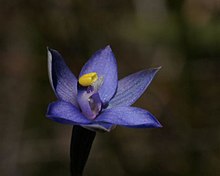| Blue star sun orchid | |
|---|---|

| |
| Thelymitra holmesii in the Southern Grampians | |
| Scientific classification | |
| Kingdom: | Plantae |
| Clade: | Tracheophytes |
| Clade: | Angiosperms |
| Clade: | Monocots |
| Order: | Asparagales |
| Family: | Orchidaceae |
| Subfamily: | Orchidoideae |
| Tribe: | Diurideae |
| Genus: | Thelymitra |
| Species: | T. holmesii |
| Binomial name | |
| Thelymitra holmesii Nicholls | |
| Synonyms | |
| |
Thelymitra holmesii, commonly called the blue star sun orchid, is a species of orchid that is endemic to south-eastern Australia. It has a single long, narrow, fleshy leaf and up to nine purplish blue to mauve flowers with a deeply notched lobe on top of the anther.
Description
Thelymitra holmesii is a tuberous, perennial herb with a single erect, fleshy, channelled, linear leaf 70–350 mm (3–10 in) long and 3–10 mm (0.1–0.4 in) wide with a purplish base. Up to nine purplish blue to mauve flowers 12–22 mm (0.5–0.9 in) wide are arranged on a flowering stem 200–650 mm (8–30 in) tall. There are two bracts on the flowering stem. The sepals and petals are 6–15 mm (0.2–0.6 in) long and 3.5–8 mm (0.1–0.3 in) wide. The column is pale to dark mauve or pink, 4.5–5.5 mm (0.18–0.22 in) long and 2.5–3.5 mm (0.098–0.14 in) wide. The lobe on the top of the anther is dark purple to almost black with a curved, deeply notched yellow top. The side lobes have loose tufts of white, toothbrush-like hairs. The flowers are self-pollinated and only open on hot days, and then only slowly. Flowering occurs from October to December.
Taxonomy and naming
Thelymitra holmesii was first formally described in 1933 by William Henry Nicholls from a specimen collected near Portland and the description was published in The Victorian Naturalist. The specific epithet (holmesii) honours "Murray Holmes, a youthful and energetic orchidologist".
Distribution and habitat
The blue star sun orchid grows in winter wet or swampy places, sometimes in disturbed areas, forest woodland or heath. It grows in southern Victoria, near Bundanoon in New South Wales, in the south-east of South Australia and in scattered populations in Tasmania.
Conservation
Thelymitra holmesii is listed as "vulnerable" in South Australia and as "rare" under the Tasmanian Threatened Species Protection Act 1995.
References
- ^ "Thelymitra holmesii". World Checklist of Selected Plant Families (WCSP). Royal Botanic Gardens, Kew.
- ^ Jones, David L. (2006). A complete guide to native orchids of Australia including the island territories. Frenchs Forest, N.S.W.: New Holland. p. 235. ISBN 1877069124.
- ^ Stajsic, Val. "Thelymitra holmesii". Royal Botanic Gardens Victoria. Retrieved 20 May 2018.
- ^ Jeanes, Jeffrey A. (2004). "A revision of the Thelymitra pauciflora R.Br. (Orchidaceae) complex in Australia" (PDF). Muelleria. 19: 73–77. Retrieved 20 May 2018.
- "Thelymitra holmesii". APNI. Retrieved 20 May 2018.
- ^ Nicholls, William H. (1932). "A new sun orchid". The Victorian Naturalist. 49: 262–263. Retrieved 20 May 2018.
- ^ "Threatened species profile Thelymitra holmesii" (PDF). Government of South Australia Department for Environment and Heritage. Retrieved 20 May 2018.
- ^ "Tasmanian threatened species listing statement Thelymitra holmesii". Tasmanian Government Department of Primary Industries, Parks, Water and Environment. Retrieved 20 May 2018.
External links
 Media related to Thelymitra holmesii at Wikimedia Commons
Media related to Thelymitra holmesii at Wikimedia Commons Data related to Thelymitra holmesii at Wikispecies
Data related to Thelymitra holmesii at Wikispecies